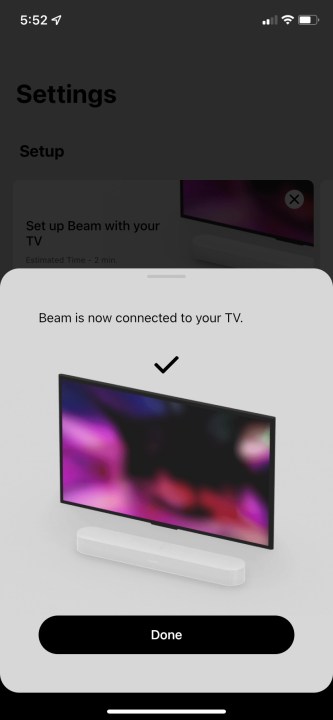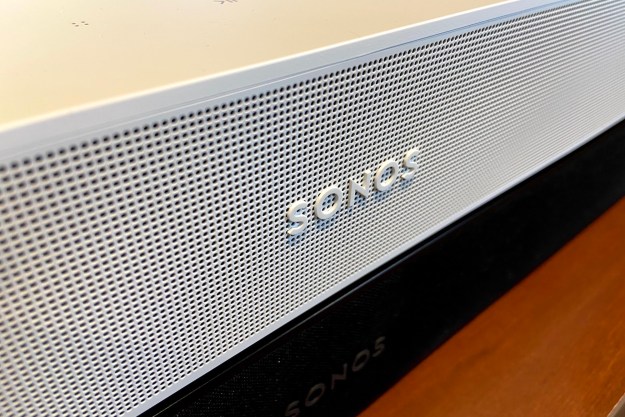
- Easy setup
- Immersive, room-filling sound
- Sleek design
- AirPlay 2
- No HDMI inputs
- Requires compatible TV for Dolby Atmos
Since its debut in 2018, the $399 Sonos Beam has been one of the best small-sized soundbars you can buy, thanks to its great sound, compact and elegant design, easy integration with Sonos’ whole-home sound platform, and its ability to double as an Alexa or Google Assistant smart speaker.
But over the past few years, Dolby Atmos — the 3D surround sound format that makes movies and music much more immersive — has become very popular, helped in no small part due to adoption by streaming giants like Netflix, Disney+, Amazon Prime Video, and both Apple TV+ and Apple Music. This means that most new soundbars, including Sonos’ $799 Arc flagship soundbar, are now Atmos-compatible, and the second-gen Beam is no exception.
The new Sonos Beam is more expensive at $449. So the questions are whether existing Beam owners should even think about upgrading, and what prospective Beam newcomers can expect from it.
A few small changes
First things first: Before you read this hands-on review, check out our review of the original Sonos Beam. Sonos has made very few changes to the second-gen version. So from here on in, I’ll only discuss what those changes are, and how they affect the Beam’s performance.
I’m a fan of the grille. It’s way easier to clean and doesn’t attract as much dust in the first place.
Some of these changes are relatively minor, like the decision to replace the fabric speaker grille with one that is made from rigid plastic. The biggest change is to the sound, which I’ll cover in a moment. It’s worth noting, however, that even though I’ll be discussing the changes Sonos has made to the Beam, this isn’t an attempt to determine which one is better, because barring any remaining Gen 1 inventory, the second-gen Beam is now the only one you can buy.
What’s in the box?
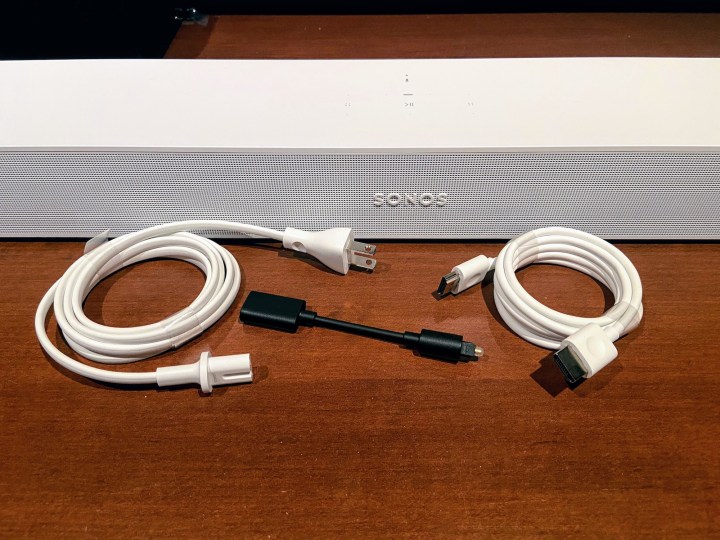
Sonos always has been the king of simplicity, and that extends from its setup and software to its packaging. The new Beam comes in a plainly printed, fully recyclable box, and the only plastic you’ll find are the two small poly bags that protect the included HDMI cable and optical-to-HDMI adapter. If Sonos can find a way to delete these bags, it will have one of the most sustainable packages in the industry.
Inside the box, you’ll find the Beam, color-matched power and HDMI cables, that adapter I mentioned, and some printed material for warranties, etc.
Great grille
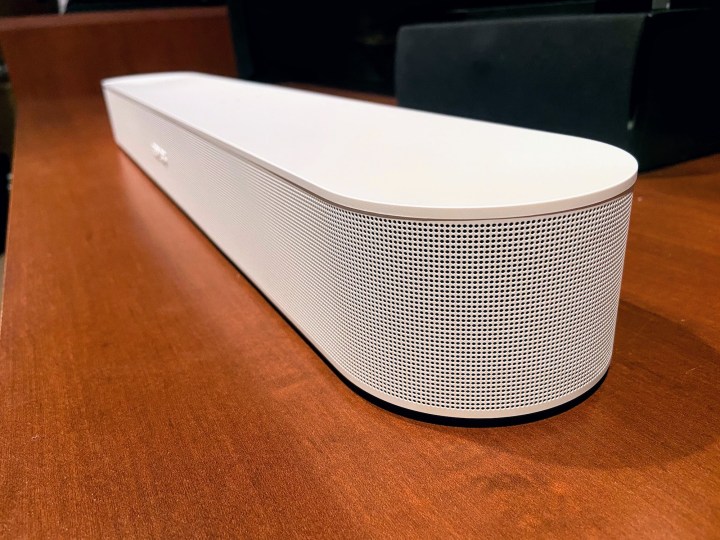
I like the traditional look of fabric grilles on a speaker. But as the owner of two cats, I can attest to the fact that fabric grilles tend to be dust and fur magnets that require pretty constant cleaning. I don’t know if this was the thinking at Sonos when it decided to replace the first-gen Beam’s fabric grille with a perforated plastic version, but I’m a fan. It’s way easier to clean and doesn’t attract as much dust in the first place.
Setting up Sonos products has always been remarkably easy. The new Beam is even easier.
The white gen-2 review unit Sonos sent me looks great. And if you’re a die-hard white product fan, this new Beam will match every other white Sonos speaker you might own, from the Sonos One to the tiny new Roam.
An (even) easier setup
Setting up Sonos products has always been remarkably easy. Plug it in, open the Sonos app, tap a few settings, and press a button or two on the speaker. Two minutes later and you’re done. The new Beam is, unbelievably, even easier to set up thanks to Sonos’ use of near-field communication (NFC). As soon as I plugged the Beam into the wall and fired up the Sonos S2 app, the app recognized the Beam and prompted me to finish the setup.
This would have been as easy as tapping my iPhone against the top surface of the Beam, but my phone case is ludicrously thick (it’s designed to mount the phone to a motorcycle), so that part didn’t work. Cleverly, the app saw that I was having trouble and asked if I wanted to switch to an audio-based setup. Saying yes, it asked me to hold the phone next to the speaker while the speaker played a coded audio tone. Five seconds later, I was done. I have to give mad props to Sonos — the company just keeps making it easier to work with its products.
Even the connection to my TV was a breeze. Once that HDMI cable is plugged in, the Beam automatically identifies your TV and figures out which commands it will need to control it, which will come in especially handy if you opt to use Alexa’s TV control skills.
Is it Atmos?

Dolby Atmos can be tricky technology to understand. In an ideal world, we’d all buy dedicated 5.1.2 or better home theater systems with at least two ceiling speakers to give us all of the juicy hemisphere-of-sound effects that Atmos is known for. That’s not realistic for most of us, which is why Dolby Atmos soundbars have become so popular. With built-in up-firing drivers that bounce sound off the ceiling and down to our ears, the best Atmos soundbars deliver a highly convincing substitute for those installed ceiling speakers. But here’s the thing with Dolby Atmos: It can actually be delivered through as few as two channels thanks to sound virtualization, which uses some very clever brain-tricking techniques to simulate the presence of up-firing or ceiling-based height channels.
With the addition of virtualized surround sound, it’s an even more formidable addition to your TV.
How well that virtualization works depends on a whole host of factors including the size of the soundbar, the number of drivers it can leverage to create that simulated sound, the size and shape of your room, and even whether you’ve set the soundbar on a tabletop or wall-mounted it.
In general, this kind of virtualized Atmos sound simply can’t compete with what you’ll get from dedicated speakers, and the new Beam is no exception. However, Sonos has managed to extract a surprising amount of additional immersion from what is, under that perforated grille, the exact same driver setup as the first-gen Beam.
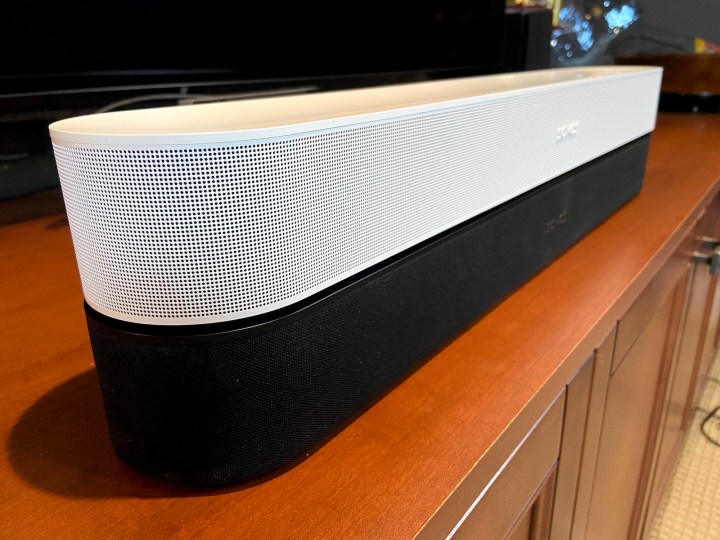
To try to get a sense of the difference between the first- and second-gen models, I stacked them vertically and played a variety of content, switching the HDMI cable back and forth between them. The new Beam’s soundstage is significantly wider, and when playing Atmos content, you do get a small but noticeable height effect. The Beam has always punched well above its weight class when it comes to its ability to fill a room with great sound, and with the addition of virtualized surround sound, it’s an even more formidable addition to your TV.
For fun, I tried out the recently remastered 1980s classic Top Gun. Sure enough, those epic dogfighting scenes and the iconic opening sequence aboard the deck of an aircraft carrier sounded fantastic. The Beam still lacks the deep low-end rumble of soundbars that come with their own subwoofers, but I was pleasantly surprised at just how well it was able to mimic a full surround system. What’s even more surprising is how well this effect carries over into standard 5.1 content.
There were a few occasions when I thought the first-gen Beam delivered slightly more intelligible dialogue, but the difference was minor.
The one-port problem
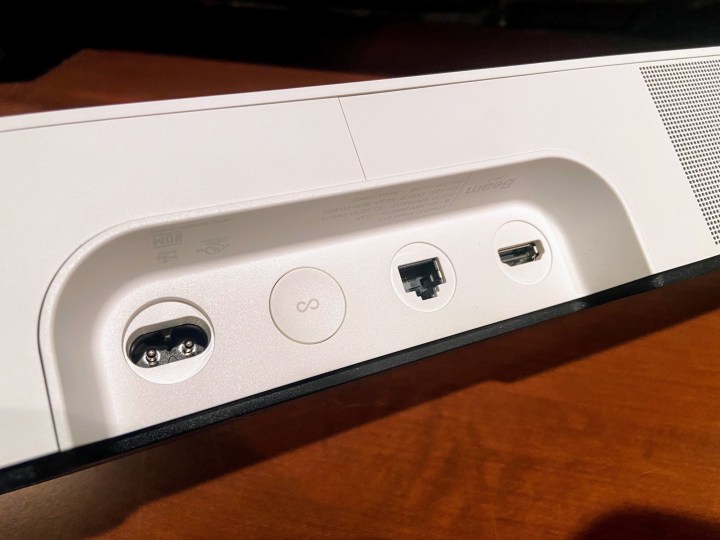
The new Beam has a single HDMI ARC/eARC port for connecting to a TV. The eARC part is new — it lets HDMI eARC-equipped TVs send a hi-res, lossless, 24-bit audio signal to the soundbar, whereas the first-gen Beam was limited to lossy digital audio. That single port wasn’t a serious limiting factor for the first-gen Beam because the speaker wasn’t able to decode anything more than Dolby 5.1, which meant that any TV from the past 15 years could take advantage of its full capabilities even if it meant using an optical-to-HDMI adapter.
But with the new Beam’s Dolby Atmos powers, this is no longer the case. To hear Dolby Atmos from the new Beam, your TV must support Dolby Atmos, too. Moreover, if you want to hear Dolby Atmos from your other devices (like streaming boxes, game consoles, or Blu-ray players), they must be plugged into your TV’s HDMI inputs. There’s simply no other way to get Atmos content to the new Beam.
If you have a Dolby Atmos TV with plenty of HDMI ports, this should work out fine. But if your TV isn’t Dolby Atmos compatible, you’ll never get the full benefit of this speaker. Many other Atmos soundbars come equipped with at least one HDMI input, giving you the option of plugging in an Apple TV 4K or a Roku Ultra. This would send the Atmos content directly to the speaker while passing through video to the TV, but that’s not an option with the new Beam.
For Dolby Atmos Music, Sonos plans to add support for this format later this year. It will begin with Amazon Music HD, but hopefully, other services that offer Atmos Music and lossless music like Tidal and Apple Music, will be added soon after.
Conclusion
The Sonos Beam is now a little more expensive, but it’s worth it. The additional immersion offered by the speaker’s virtualized Dolby Atmos and 5.1 surround sound take an already capable soundbar for movies and music and make it that much better. If you have an Atmos-capable TV, it’s worth upgrading to take advantage of the better sound. Even if your TV isn’t Atmos-enabled, the new Beam can provide improved immersion over its predecessor, but the difference will be less noticeable.



